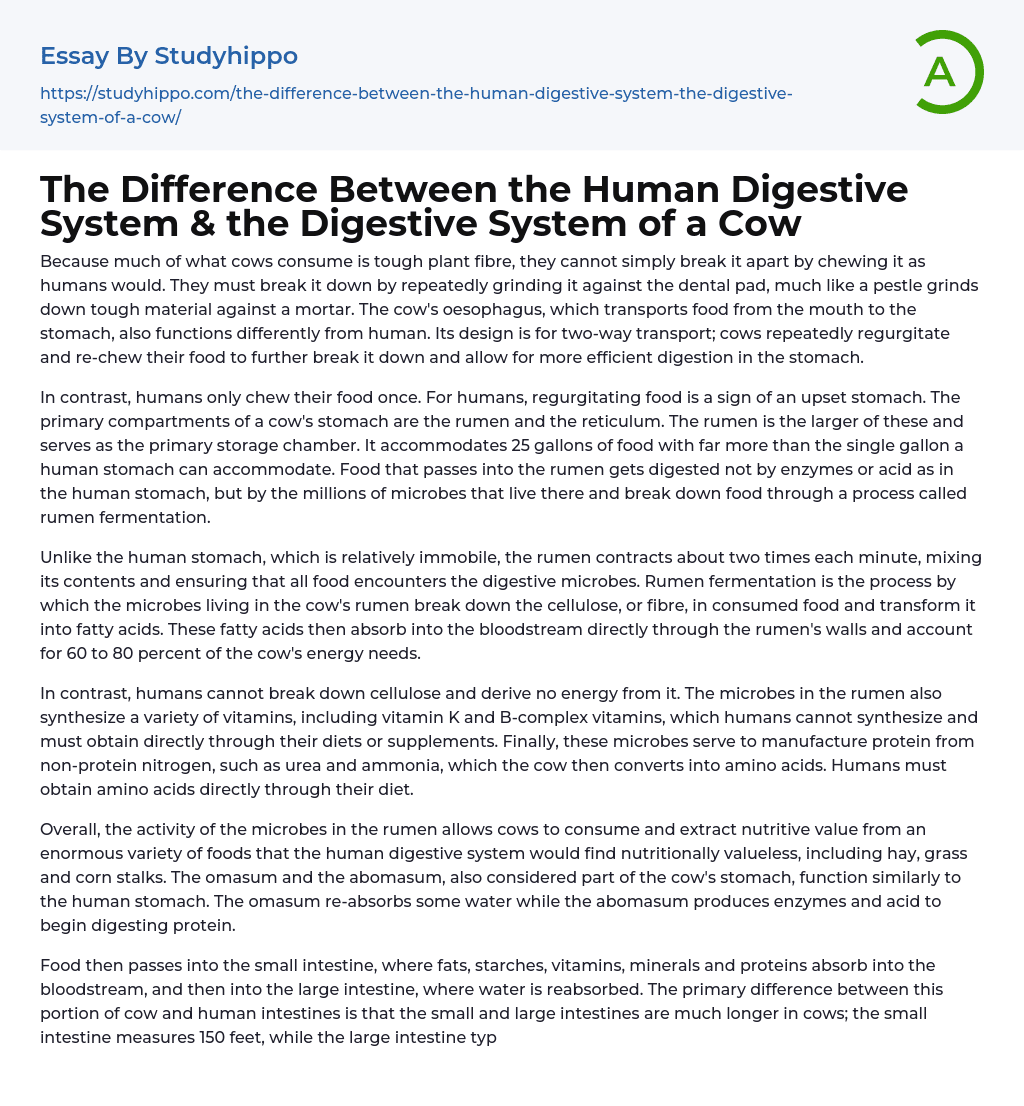

The Difference Between the Human Digestive System & the Digestive System of a Cow Essay Example
Because much of what cows consume is tough plant fibre, they cannot simply break it apart by chewing it as humans would. They must break it down by repeatedly grinding it against the dental pad, much like a pestle grinds down tough material against a mortar. The cow's oesophagus, which transports food from the mouth to the stomach, also functions differently from human. Its design is for two-way transport; cows repeatedly regurgitate and re-chew their food to further break it down and allow for more efficient digestion in the stomach.
In contrast, humans only chew their food once. For humans, regurgitating food is a sign of an upset stomach. The primary compartments of a cow's stomach are the rumen and the reticulum. The rumen is the larger of these and serves as the primary
...storage chamber. It accommodates 25 gallons of food with far more than the single gallon a human stomach can accommodate. Food that passes into the rumen gets digested not by enzymes or acid as in the human stomach, but by the millions of microbes that live there and break down food through a process called rumen fermentation.
Unlike the human stomach, which is relatively immobile, the rumen contracts about two times each minute, mixing its contents and ensuring that all food encounters the digestive microbes. Rumen fermentation is the process by which the microbes living in the cow's rumen break down the cellulose, or fibre, in consumed food and transform it into fatty acids. These fatty acids then absorb into the bloodstream directly through the rumen's walls and account for 60 to 80 percent of the cow's
energy needs.
In contrast, humans cannot break down cellulose and derive no energy from it. The microbes in the rumen also synthesize a variety of vitamins, including vitamin K and B-complex vitamins, which humans cannot synthesize and must obtain directly through their diets or supplements. Finally, these microbes serve to manufacture protein from non-protein nitrogen, such as urea and ammonia, which the cow then converts into amino acids. Humans must obtain amino acids directly through their diet.
Overall, the activity of the microbes in the rumen allows cows to consume and extract nutritive value from an enormous variety of foods that the human digestive system would find nutritionally valueless, including hay, grass and corn stalks. The omasum and the abomasum, also considered part of the cow's stomach, function similarly to the human stomach. The omasum re-absorbs some water while the abomasum produces enzymes and acid to begin digesting protein.
Food then passes into the small intestine, where fats, starches, vitamins, minerals and proteins absorb into the bloodstream, and then into the large intestine, where water is reabsorbed. The primary difference between this portion of cow and human intestines is that the small and large intestines are much longer in cows; the small intestine measures 150 feet, while the large intestine typically measures 33 feet. In humans, these numbers are 20 feet and 5 to 7 feet, respectively.
In conclusion there are plenty of similarities in a cows and man’s digestive system but there is also a lot of differences between them; Cows have a digestive system that enables them to eat and digest plant matter more efficiently than humans. It is
this difference that makes cows able to eat roughage and coarser forages than what humans are able to chew through. Humans, on the other hand, are more able to digest animal proteins more efficiently than cows. Essentially, cows are herbivores and humans are omnivores by natural selection and evolution. References:
Ezinearticles/ Julie Eden. 2007. A Comparison Between the Human and Ruminant Digestive System. Available at: http://ezinearticles. com/? A-Comparison-Between-the-Human-and-Ruminant-Digestive-System&id=2782515. [Accessed 18 October 12]. Cliff Notes. 2010. Human Digestive System. Available at: http://www. cliffsnotes. com/study_guide/Human-Digestive-System. topicArticleId-8741,articleId-8705. html. [Accessed 20 October 12]. Nutrition and Feeding of the Cow-Calf Herd: Digestive System of the Cow, (2009), Compartments of the stomach of cattle [ONLINE]. Available at:
- Food essays
- Genetically Modified Organisms essays
- Child Development essays
- Eating essays
- Breakfast essays
- Genetically Modified Food essays
- Milk essays
- Chewing gum essays
- Energy Drink essays
- Caffeine essays
- Chocolate essays
- vegetarian essays
- Weight Loss essays
- Anorexia essays
- Metabolism essays
- Diet essays
- Vitamin essays
- Dieting essays
- Junk Food essays
- Eating Habits essays
- Food Safety essays
- Food Security essays
- Beverages essays
- Cuisines essays
- Dairy essays
- Desserts essays
- Fast Food essays
- Bread essays
- Meal essays
- Meat essays
- Organic Food essays
- Rice essays
- Sugar essays
- Taste essays
- Beef essays
- Coconut essays
- Crowd essays
- Dinner essays
- Juice essays
- Sainsbury essays
- Cooking essays
- Ginger essays
- Oreo essays
- Drink essays
- Beer essays
- Wine essays
- Coffee essays
- Tea essays
- Cake essays
- Hamburger essays



